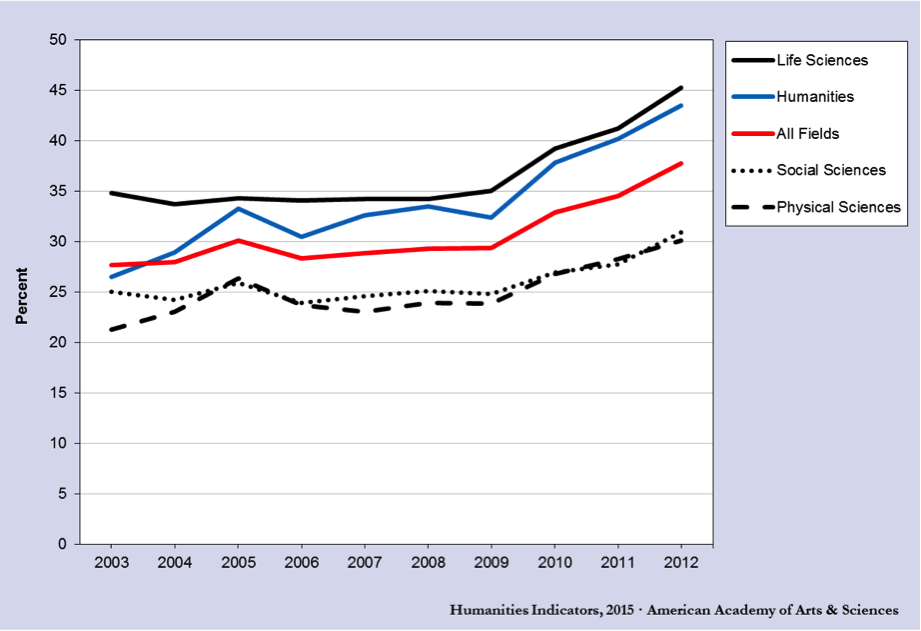You have /5 articles left.
Sign up for a free account or log in.
Many academics these days say that much of the most exciting scholarship is interdisciplinary. But some fear that doctoral students feel obliged to stay within disciplinary lines.
A new study finds that increasing numbers of Ph.D. students are pursuing interdisciplinary projects for their dissertations. But the study also finds that most of the interdisciplinary work is in fields that are close to the Ph.D. students' primary field -- suggesting less dramatic groupings of disciplines than some may imagine.
The study, released today, comes from the Humanities Indicators program of the American Academy of Arts & Sciences. It is based on data from national databases on doctoral students prepared by NORC of the University of Chicago.
Using survey data, the Humanities Indicators researchers found that from 2003 to 2012, the share of new Ph.D. recipients who classify their dissertation work as interdisciplinary increased by 23 percent or more in each of the major academic field categories studied (humanities, life sciences and social sciences). The largest increase was in the humanities, where the proportion of doctorate recipients reporting interdisciplinary research increased to 43.5 percent. But a greater share of people with life sciences doctorates (45.3 percent) reported interdisciplinary work.
Ph.D. Recipients Reporting Interdisciplinary Dissertations
The survey data also show the secondary fields of the doctorate recipients. For 2011-13, the most recent cohort for which the data were studied, the research found that in the vast majority of cases, dissertations that were interdisciplinary involved other fields in the same general area as the original discipline. In other words, life sciences dissertations ended up with another life sciences field, and only rarely were based on collaboration with the humanities or social sciences.
Further, some of those aren't even leaving the disciplines that house their programs, but consider it interdisciplinary when they work with another subfield within their own discipline. The overall trend, the report found, is for people to stay close to home when going interdisciplinary.
Robert B. Townsend, director of the Washington office of the American Academy of Arts & Sciences, said he wasn't sure if this more narrow approach to interdisciplinarity was a good thing or not.
Taking his own field of history, Townsend said, "I’m not sure whether it suggests historians think work in U.S. history is really that distant from, say, Asian history, or they are just confused about the meaning of the term."
But he said that the findings point to the need for discussion about interdisciplinarity and the borders between disciplines.
Harvey J. Graff, the Ohio Eminent Scholar in Literacy Studies and a professor of English and history at Ohio State University, is the author of a new book, Undisciplining Knowledge: Interdisciplinarity in the 20th Century (Johns Hopkins University Press).
Graff said he was not surprised by the new findings on dissertations -- and said that the study points to broader issues.
"In my view, interdisciplinarity is among the most misunderstood and misused term[s] in contemporary academic discourse," Graff said via email. "That is true for both strong proponents and loud opponents. Well-grounded, knowledgeable interdisciplinarity is among the most important critical paths to new approaches and path-breaking research, teaching and program development. It remains rare. I strongly suspect that 'mild' or 'slight' interdisciplinarity refers much more to cross- or multidisciplinarity -- or even to faux interdisciplinarity -- rather than developed interdisciplinarity.
"It also reflects anxieties and confusions. I do not believe that one can distinguish degrees of interdisciplinarity, or refer to weak or mild forms, like coffee, hot sauce, or various regional or ethnic cuisines. That misunderstands the very nature of interdisciplinarity -- which is part of the history and development of modern research and the modern research university from its beginnings."






